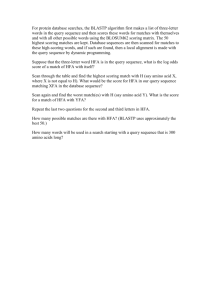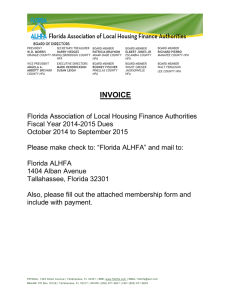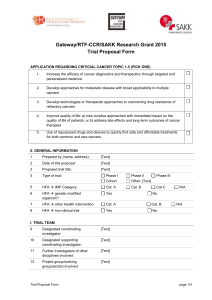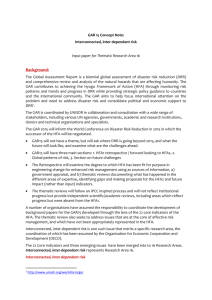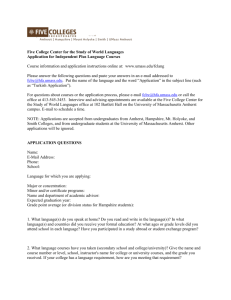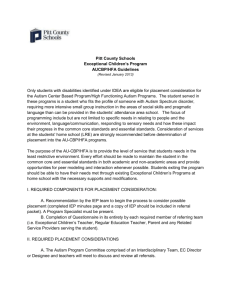Ciavarelli_SND_Signal Charlie September 2012
advertisement
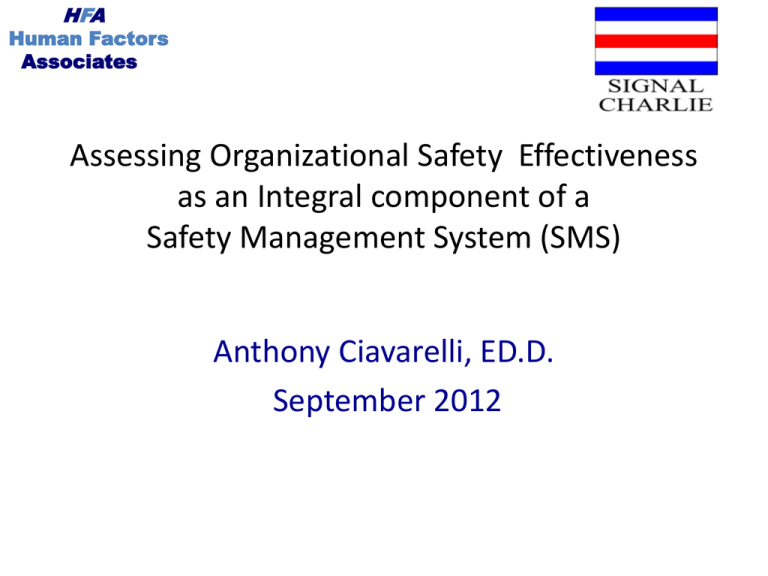
HFA Human Factors Associates Assessing Organizational Safety Effectiveness as an Integral component of a Safety Management System (SMS) Anthony Ciavarelli, ED.D. September 2012 HFA Human Factors Associates AGENDA • • • • • • • Organizational Accidents Sources of Human Error High - Reliability Organizations Organizational Effectiveness and Safety Culture Assessing Safety “culture” -- Climate Safety Status of Aviation and Aerospace SMS Implementation and Safety Culture Copyright © HFA HFA Human Factors Associates Aviation and Aerospace Accidents • Air Florida Washington DC “start up airline” • ValuJet Florida Everglades “outsourced cargo services” • Challenger Space Shuttle “risk perception -- decision”- o-rings • Columbia Space Shuttle “risk perception—decision”- foam • Buffalo “aircraft control to stall” – pilot training & fatigue • Air France 447 – aircraft design & pilot training Copyright © HFA HFA Human Factors Associates Sources of Human Errors • Attitudes about job safety and performance • Culture of Safety is deficient in key areas, such leadership commitment and non-punitive reporting • Inadequate standards, training and monitoring of practitioner qualifications • Poor communications and information flow • Non-compliance with rules or best practices • Stress, fatigue, production pressure, short staffing and lack of resources Copyright © HFA HFA Human Factors Associates Supervisory Contributions • • • • • • • • Failure to instill strong safety values/culture Pressure to complete a job or meet schedule. Failure to establish or enforce standards. Over-tasking pilots or maintainers Failure to manage fatigue or stress. Inadequate resources to perform job safely. Poor equipment operating status/reliability. Failure to manage known risks, including high-risk pilots or maintainers, or other front line personnel. Copyright © HFA HFA Human Factors Associates Naval Aviation Major (Class A) Flight Mishaps 7 aircraft destroyed in FY-11 all in flight mishaps 776 aircraft destroyed in 1954 Angled Decks Aviation Safety Center Naval Aviation Maintenance Program RAG (FRS) Concept Initiated NATOPS Program Squadron Safety Program System Safety Aircraft Design CRM (crew-resource-mgmt) Aircrew reviews Risk management (ORM) Safety climate-culture October 2011 Fiscal Year HFA Human Factors Associates High Reliability - US Naval Aviation Copyright © HFA HFA Human Factors Associates High Reliability - US Naval Aviation Copyright © HFA HFA Human Factors Associates Naval Aviation Risk Mitigation • • • • • • • • Recruitment and selection Aeromedical screening Training standardization and qualifications Command supervision and risk management Aircrew performance reviews Human Factors reviews (Boards & Councils) Crew Resource Management (CRM) Safety Climate and Culture Assessments Copyright © HFA HFA Human Factors Associates Key Organizational Accident Theories Human Factors, Inc. • • • • • • Incubation Periods (Turner,1978) The Normal Accident (Perrow, 1984) The High-Reliability Organization (Roberts, 1993) Organizational Culture (Shein, 1990) Normalization of deviance (Vaughn, 1997) Organizational Sense-making (Weick, 1999) Copyright © HFA HFA Human Factors Associates High Reliability - Safety Culture Human Factors, Inc. Copyright © HFA HFA Human Factors Associates Organizational Culture Shared Values (What is important) and Beliefs (How things work) that interact with an organizations structures and control systems to produce Behavioral Norms (The way things work around here). (Adapted: DuPont Culture 98 -- originally Reason 1990) Copyright © HFA HFA Human Factors Associates High - Reliability Organization (HRO) • A culture of trust, shared values, and risk mitigating communication processes. • Communication that provides opportunities for open discussion and improvement. • Distributed decision-making, “where the buck stops everywhere.” (Roberts, 1997) Copyright © HFA HFA Human Factors Associates Safety Culture • Shared values about what is safe and unsafe • Common beliefs about how to conduct safe operations • Behavioral norms that govern risk-taking, everyday procedures and precautions • Transmission of values, beliefs and accepted practices to others. Copyright © HFA HFA Human Factors Associates Emergence of Just Culture Culture Concept The phrase just culture refers to the principles for achieving a culture in which frontline personnel feel comfortable disclosing errors—including their own—while maintaining professional accountability... A just culture recognizes that individual practitioners should not be held accountable for system failings over which they have no control. A just culture also recognizes anyone can produce errors as a consequence of predictable interactions between human operators and the systems in which they work. However, in contrast to a culture that turns to blame as its governing principle, a just culture does not tolerate conscious disregard of rules, reckless behavior or gross misconduct (AHRQ 2008) Copyright © HFA HFA Human Factors Associates A Concise Definition of Safety Culture Strictly speaking, the survey metrics are measuring “safety climate”, which is considered a snapshot of employee attitudes that reflect the underlying culture of the organization Flin, Mearns, O’Connor and Bryden (2000). We use the findings of the survey to address specific issues regarding the state of a company’s safety culture, which is defined as: “The values, beliefs, and prevailing practices regarding safety that are routinely demonstrated and passed on to all employees from generation to generation.” Copyright © HFA HFA Human Factors Associates Copyright © HFA HFA Human Factors Associates Copyright 2001-2007 HFA, Inc Sample Survey Items . Copyright © HFA HFA Human Factors Associates Survey Items Copyright 2001-2007 HFA, Inc. Copyright © HFA HFA Human Factors Associates Copyright 2001-2007 HFA, Inc. Survey Items HFA Human Factors Associates Copyright © HFA HFA Human Factors Associates Copyright © HFA HFA Human Factors Associates High Reliability Organizational (HRO) Model SPA SCRS RSKM Copyright © HFA QA LDSHP HFA HRO Performance Dashboard Human Factors Associates SPA QA SCRS RSK MNGT LDSHP Diagnostic Feedback: Fictitious Data 100% 5,0 90% 4,5 80% 4,0 70% 60% 3,5 50% 3,0 40% 2,5 30% 20% 2,0 1 3 5 7 9 11 13 15 17 19 21 23 25 Copyright 2001-2007 Human Factors Associates, Inc. 27 29 31 33 Copyright © HFA 35 37 39 41 43 45 47 49 51 53 55 57 59 HFA Human Factors Associates Placement of a specific rating on Normal Distribution Curve Rating is 1 standard deviation below mean Rating is in 14th percentile 86% of ratings are above this one Copyright © HFA HFA Human Factors Associates Copyright 2001-2007 HFA, Inc. Feedback Display (fictitious data) HFA Human Factors Associates Typical Demographic Statistics Higher Ranking Personnel Give Higher Ratings Average CSA Scores by Military Rank 5 4.5 4 3.5 Military Rank 3 O4 - O6 O1 - O3 E6 - E9 E1 - E5 2.5 Senior Commissioned Overcommitted Short Resources Junior Enlisted Rank differences statistically significant (p<.001) Survey Items Copyright © HFA 61 58 55 52 49 46 43 40 37 34 31 28 25 22 19 16 13 10 7 4 1 2 HFA Human Factors Associates Normative Data: Aviation or Aerospace 42.56% 76.03% Favorable Survey Return Rate: 50% 33.47% 9.65% Problematic 3.05% 14.23% 6.60% Copyright © HFA HFA Human Factors Associates Normative Benchmark Comparison Across Domains Comparison % Problematic Mean Major Airlines Data restricted to Airline Client US Hospitals US Navy 12.10 4.10 not reported not reported O&G off shore transport Air medical One Air medical Two Energy/Power Aerospace 19.22% 8.9% 7.5% 10.6% 7.97 % 3.5 4.0 4.0 3.8 4.1 Copyright © HFA HFA Human Factors Associates What the People on the ground have to say -- over 12 years of survey data in aviation and aerospace. • Flight Operations – – – – – – • Maintenance – – – – – – – Schedule pressure Pilot shortage Lack of trust Low morale Reluctance to report Low time pilots Copyright © HFA Schedule pressure Inadequate staffing Lack of trust Low morale Reluctance to report Hi workload - fatigue Low experience service personnel HFA Human Factors Associates International Civil Authority Study Selected Issues Identified • • • • • • • • • • Some employees are not comfortable reporting deficiencies Not all workforce trust senior management Not all senior managers are supportive of SSP – SMS activities ICAO standards – guidelines are not completely clear Legal framework may not support non-punitive reporting Management and workers do not perceive need for change There are no obvious incentives to reward change acceptance Cultural and language diversity complicates communication Employee training in SMS – and cultural impact is deficient Additional resources (budget and staffing) may be needed Copyright © HFA APEC study by HFA 2010 HFA Human Factors Associates ICAO Accident Statistics YEAR Accidents Fatalities/Rate 2005 119 824 / 4.2 2006 112 806 / 3.9 2007 122 645 / 4.0 2008 138 534 / 4.6 2009 113 670 / 3.9 2010 121 707 / 4.0 ICAO 2011 State of Global Safety HFA ICAO Statistics Human Factors Associates ICAO 2011 State of Global Safety State Accident Rate Safety Indicators (practice effectiveness} Africa 16.8 41% Asia 3.1 61% Europe 3.3 72% Lat. Amer/Car. 5.4 64% North America 3.3 93% Oceana 4.8 47% Rates and % Effectiveness are Correlated. Note: The accident rate is defined as number of accidents per million departures. HFA Human Factors Associates ICAO Global Areas of Concern • • • • Fatigue risk management Runway safety Accident investigation (flight recordings) Next generation safety professionals What about – UAVs, cockpit automation, and next gen ATC, global economy and resources? HFA Human Factors Associates Survey Application Process 1. 2. 3. 4. 5. 6. 7. HFA representatives gather safety documentation and conduct interviews with a cross section of company/agency employees. HFA constructs tailored survey based on the use of previously validated survey items and inputs from document review and personnel interviews. A draft survey is presented to safety personnel for review and revision, then finalized for survey application. The final survey and demographic information are uploaded to the web or a scanable paper version is created, . The survey is administered in accordance with preplanned schedule of events, including announcements/survey instructions, survey distribution, collection and analysis of survey data, and results reporting. Results are presented along with recommendations for safety improvement interventions where warranted. A time frame is established for a follow on second survey round which will provide results to be compared to the original “benchmark” Survey. Copyright © HFA HFA Human Factors Associates END Summary and Conclusions • Survey process for use as a risk assessment tool – validation of survey instrument is continuous – US Navy, major airline and NASA study. • Approach incorporates a complete measurement, analysis and diagnostic display “dashboard” system for supervisors that provides diagnostic feedback and normative “benchmark” comparisons for a given company, industry or domain. • Survey process was successfully used by civilian organizations, helicopter transport, aerospace, airline, electric power, and critical medical care facilities. • Approach applies to other high-risk industries, that desire to asses their • HRO performance effectiveness and risk exposure. Demonstration Web Site: https://www.hfa-clients.com/demosite/login.html Copyright © HFA
